< Previous
'VERY LITTLE INCONVENIENCE TO THE PUBLIC':
A Sneinton bottleneck remembered
By Stephen Best
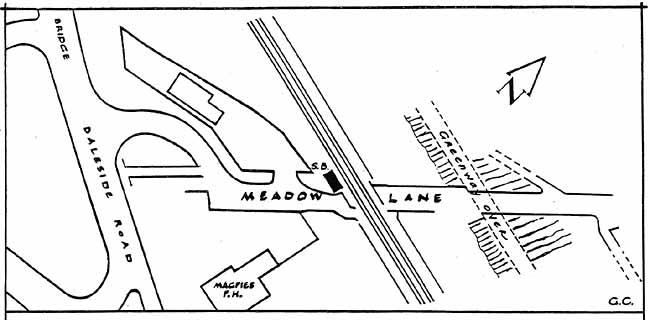 SKETCH MAP as at February 29 1996. Not to Scale.
SKETCH MAP as at February 29 1996. Not to Scale.'I have quite as strong an objection to level crossings as anybody can have, and they are a source of constant expense to the railway company, but there are cases in which it is impossible to avoid them... yet the result of experience proves that they are really are attended with no danger, and very little inconvenience to the public...’
(Isambard Kingdom Brunel. 1854)
THE FOLLOWING PHOTOGRAPHS feature what was, depending on one’s point of view, either Sneinton's prime cause of annoyance to motorists, or one of its never-failing features of interest. This was, of course, the Meadow Lane level crossing on the Nottingham-Lincoln line of the old Midland Railway, from 1966 traversed also by trains following the former Great Northern route to Grantham. Until the mid 1960s this had been one of five separate railway lines to cross Meadow Lane. Coming from the direction of Trent Bridge, first encountered was a bridge carrying the Midland main line to London, via Melton Mowbray. Though this bridge has long been demolished, the adjacent railway bridge over the Trent, now known as Lady Bay Bridge, remains as an important part of Nottingham's road network. The level crossing illustrated here came next, with the other rail routes following in quick succession. First of these was the 1857 Great Northern line to Nottingham, taking trains from the London Road Station and its yard across Meadow Lane, and thence to Grantham, to the Nottingham Suburban Railway, or to Colwick and points on the old Great Northern north and west of Nottingham. A girder bridge which carried this traffic still spans the road. With the opening of Nottingham Victoria Station at the turn of the century, a new line was built, diverting most of the trains away from London Road Station, which received the suffix 'Low Level', to distinguish it from the High Level station opened on the new route. The bridge carrying this new line spanned the Lane a few yards nearer Sneinton, the lines on it joining those from the 1857 route just east of Meadow Lane, at Trent Lane Junction. Finally came what may be the least-remembered of the bridges spanning Meadow Lane; this was a massive masonry arch which took the Manvers Street Goods Branch of the old London & North Western from Trent Lane, over Meadow Lane and Sneinton Hermitage, and into the goods station which closed in 1966, and whose site is now occupied by Newark Crescent.
Road users rarely noticed the rail traffic on four of these lines; the trains which infuriated car drivers were those on the Midland line, whose level crossing gates were, said many motorists, always closed against them. It is, perhaps, ironic that the route over the level crossing is now the last surviving line over Meadow Lane, though since the closure of the road to through traffic it no longer presents an obstruction to road vehicles. In view of the survival of the level crossing, while all the bridge-borne lines have gone, it is interesting to discover that a rationalisation of the railways at Meadow Lane was indeed suggested as long ago as 1952, though it was then proposed that the one to go should be the old Midland route, with its much-vilified level crossing. The Nottingham Guardian of February 2 1952 reported that Councillor Christopher Coffey intended to ask the chairman of the City Council's Works & Ways Committee if he would approach the Railway Executive on this matter. Coffey's view was that the three level crossings in Sneinton were a thorough nuisance. 'There shouldn't be any in 1952', he asserted; 'It is wrong that a city like Nottingham should have them running through her streets. Other cities would be glad to get rid of them.'
Purely from the standpoint of the motorist, the councillor’s view possessed a good deal of force. The LNER line crossed Meadow Lane, Trent Lane, and the racecourse approach road by bridges, while the Midland route to Lincoln involved three level crossings within a very short distance. These, as already mentioned, all lay in Sneinton, and Mr Coffey asserted that on some occasions, when the Midland Station was unable to accept westbound traffic, a train would come to a stop with its engine across the Meadow Lane crossing, and its tail blocking the one at Trent Lane. Trains in 1952 were frequently much longer than they are today, but even so one suspects that only occasional goods trains would have succeeded in baulking road users at both Meadow Lane and Trent Lane simultaneously, though, of course, both sets of gates would be closed against road traffic at the same time to allow the passage of any train. A Nottingham Guardian journalist, sent out in a car to verify the obstructive qualities of the three crossings, dutifully reported that his vehicle had been held up at all three. Whether anyone would have got so heated about being delayed at three sets of road traffic lights is open to question.
The councillor's suggestion, however, came to nothing, and the Meadow Lane crossing continued to be a major cause of delay on this busy street. One step towards reducing delays and consequent inconvenience to motorists came about late in 1969, when the old crossing gates were replaced by lifting barriers, operated in conjunction with traffic lights. Most of the accompanying photographs were taken around this date, and record the level crossing as it was being modernised. The present writer took these pictures, and, on finding them many years afterwards, was surprised to see how many features of interest they contained, despite their mediocre photographic quality.
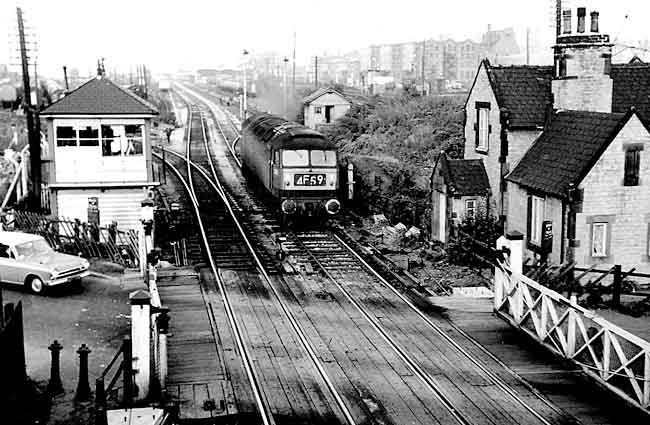 1. Sometime in September 1969 a Brush-built class 47 diesel-electric locomotive runs light across Meadow Lane, on its way, it is thought, to Colwick engine sheds, which were closed in the following April. (The correct train identification code for a light engine is not being displayed.) The old gates are here still in position, worked manually by the signalman, who turned a large wheel in Sneinton Junction signal box. The Midland Railway crossing house is inhabited at this date, and MR lineside warning notices can be seen. Passenger coaches stand in the sidings on either side of the line, and, to the right of the warehouses in London Road goods yard, part of the old Eastcroft Gasworks is dimly seen. The points beside the signal box are set for the goods avoiding line which ran to the south of the carriage sidings. Like the other photographs in this sequence, this was taken from the footbridge spanning the line at Meadow Lane.
1. Sometime in September 1969 a Brush-built class 47 diesel-electric locomotive runs light across Meadow Lane, on its way, it is thought, to Colwick engine sheds, which were closed in the following April. (The correct train identification code for a light engine is not being displayed.) The old gates are here still in position, worked manually by the signalman, who turned a large wheel in Sneinton Junction signal box. The Midland Railway crossing house is inhabited at this date, and MR lineside warning notices can be seen. Passenger coaches stand in the sidings on either side of the line, and, to the right of the warehouses in London Road goods yard, part of the old Eastcroft Gasworks is dimly seen. The points beside the signal box are set for the goods avoiding line which ran to the south of the carriage sidings. Like the other photographs in this sequence, this was taken from the footbridge spanning the line at Meadow Lane.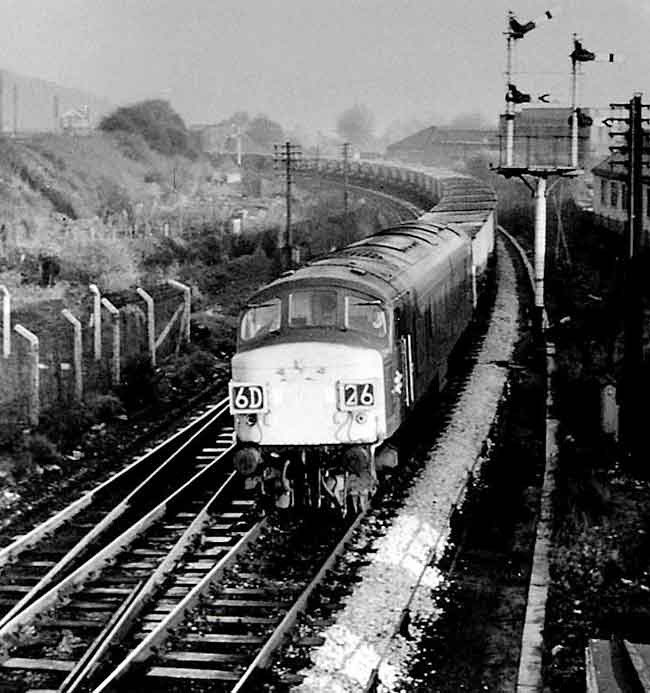 2. On November 18 1969 a westbound train of empty hopper wagons from Staythorpe Power Station approaches Meadow Lane crossing. The signal is off for the line through the Midland Station. If the train were taking the goods avoiding line the right hand signals would be raised. At this date some shunting movements were still carried out on this stretch of line, and the crossover here is clearly bright with use.
2. On November 18 1969 a westbound train of empty hopper wagons from Staythorpe Power Station approaches Meadow Lane crossing. The signal is off for the line through the Midland Station. If the train were taking the goods avoiding line the right hand signals would be raised. At this date some shunting movements were still carried out on this stretch of line, and the crossover here is clearly bright with use.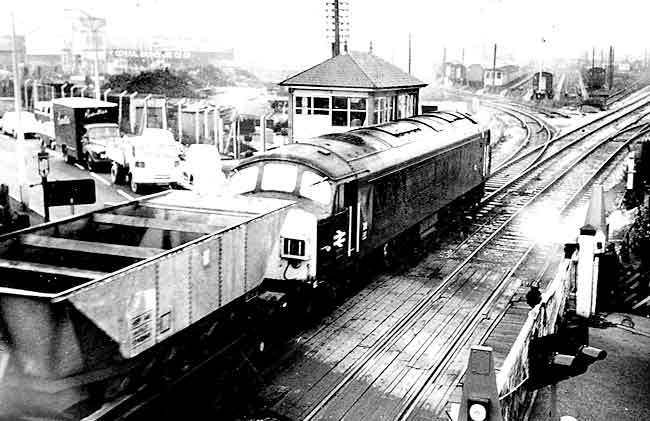 3. Hauled by class 40 locomotive no. 72, the same train crosses Meadow Lane. Installation work for the new lifting barriers has begun; the seatings for the barriers are in position, as are the traffic lights for warning road traffic. The old gates however, are not yet replaced. In the carriage sidings are a diesel unit and several rakes of older carriages. To the left, in Meadow Lane, are the premises of the Railway and General Engineering Co., while a line of road vehicles, now of distinctly vintage appearance, waits for the gates to open after the train has passed. Behind the locomotive can be seen the top of a splendid gas lamp, placed there to illuminate the footbridge stairway; the lower part of the lamp standard survives precariously today, in a increasingly decrepit state.
3. Hauled by class 40 locomotive no. 72, the same train crosses Meadow Lane. Installation work for the new lifting barriers has begun; the seatings for the barriers are in position, as are the traffic lights for warning road traffic. The old gates however, are not yet replaced. In the carriage sidings are a diesel unit and several rakes of older carriages. To the left, in Meadow Lane, are the premises of the Railway and General Engineering Co., while a line of road vehicles, now of distinctly vintage appearance, waits for the gates to open after the train has passed. Behind the locomotive can be seen the top of a splendid gas lamp, placed there to illuminate the footbridge stairway; the lower part of the lamp standard survives precariously today, in a increasingly decrepit state.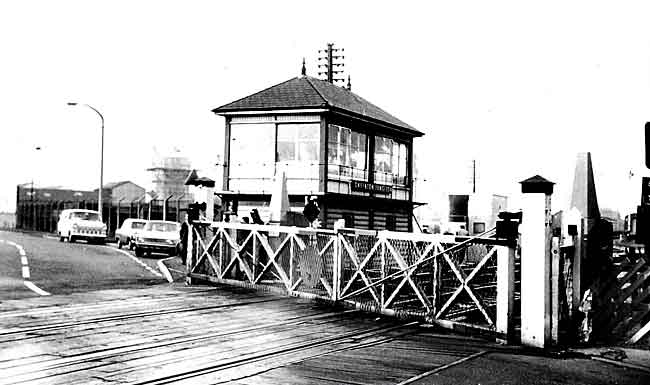 4. On the same day, Sneinton Junction signal box guards the mixture of old and new level crossing arrangements. Of Midland Railway design, though rebuilt in the 1920s, the box survives at the time of writing (1996).
4. On the same day, Sneinton Junction signal box guards the mixture of old and new level crossing arrangements. Of Midland Railway design, though rebuilt in the 1920s, the box survives at the time of writing (1996). 5. On the bright, but increasingly misty, afternoon of February 6 1970 a coal train for Staythorpe Power Station crosses Meadow Lane, hauled by two class 20 locomotives. The old gates have by now been replaced by full-skirted pairs of lifting barriers, the arrangement which survives to the present day. Vanished features of this scene are the crossing house, which might have become a deserving candidate for listing: the railway staff building on the old Great Northern embankment behind it: and the footbridge itself, an invaluable vantage point from which the Sneinton railway scene could be observed, and from which, as already mentioned, all the foregoing photographs were taken. The posts at the bottom of the footbridge steps are of similar vantage to the gas lamp in the earlier view.
5. On the bright, but increasingly misty, afternoon of February 6 1970 a coal train for Staythorpe Power Station crosses Meadow Lane, hauled by two class 20 locomotives. The old gates have by now been replaced by full-skirted pairs of lifting barriers, the arrangement which survives to the present day. Vanished features of this scene are the crossing house, which might have become a deserving candidate for listing: the railway staff building on the old Great Northern embankment behind it: and the footbridge itself, an invaluable vantage point from which the Sneinton railway scene could be observed, and from which, as already mentioned, all the foregoing photographs were taken. The posts at the bottom of the footbridge steps are of similar vantage to the gas lamp in the earlier view.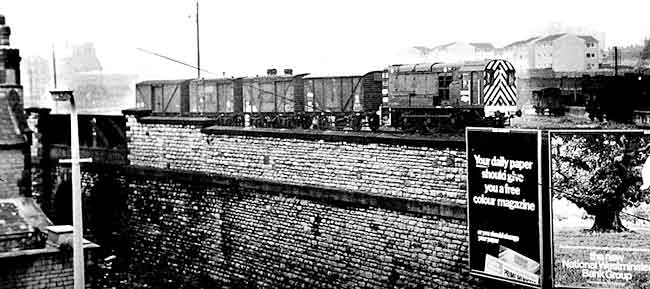 6. From the footbridge one could observe other everyday aspects of railway operation, now gone for ever. On the particularly gloomy afternoon of November 18 1969 a diesel shunter moves a rake of wagons on the embankment leading up from London Road Low Level Goods Yard. Behind the engine can be seen the cattle dock, with what appear to be a couple of cattle trucks beside it. The movement of livestock by rail was by this time almost a thing of the past, and would cease altogether in 1975. Above the locomotive can dimly be seen housing in Newark Crescent, then quite new, and built on the site of Manvers Street Goods Station. The advertising hoarding displays posters publicising the Daily Mirror Colour Magazine, and the newly formed NatWest Bank Group.
6. From the footbridge one could observe other everyday aspects of railway operation, now gone for ever. On the particularly gloomy afternoon of November 18 1969 a diesel shunter moves a rake of wagons on the embankment leading up from London Road Low Level Goods Yard. Behind the engine can be seen the cattle dock, with what appear to be a couple of cattle trucks beside it. The movement of livestock by rail was by this time almost a thing of the past, and would cease altogether in 1975. Above the locomotive can dimly be seen housing in Newark Crescent, then quite new, and built on the site of Manvers Street Goods Station. The advertising hoarding displays posters publicising the Daily Mirror Colour Magazine, and the newly formed NatWest Bank Group.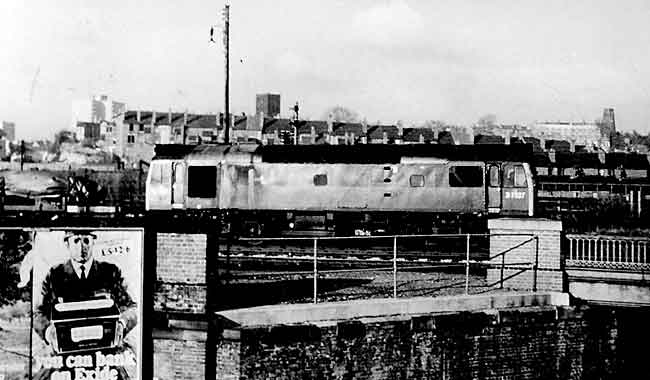 7. A week later, on November 25 1969, an eastbound freight train, headed by class 25 locomotive no. D7527, climbs to cross over Meadow Lane in late afternoon sunshine; the handsome iron parapet to the 1857 Great Northern bridge can clearly be seen. The real interest of the photograph lies in the presence in the right background of Green's Mill, still in its ruined state, and of the handsome Belvoir Terrace just in front of it. The houses of the Terrace were built in the 1830s, being advertised for letting as 'superior country residences'. After a long period of deterioration, they were pulled down towards the end of the 1970s, their site now forming the children's playground in the Mill Park. The third poster on the embankment retaining wall advertises Exide car batteries costing £5.12.6d.
7. A week later, on November 25 1969, an eastbound freight train, headed by class 25 locomotive no. D7527, climbs to cross over Meadow Lane in late afternoon sunshine; the handsome iron parapet to the 1857 Great Northern bridge can clearly be seen. The real interest of the photograph lies in the presence in the right background of Green's Mill, still in its ruined state, and of the handsome Belvoir Terrace just in front of it. The houses of the Terrace were built in the 1830s, being advertised for letting as 'superior country residences'. After a long period of deterioration, they were pulled down towards the end of the 1970s, their site now forming the children's playground in the Mill Park. The third poster on the embankment retaining wall advertises Exide car batteries costing £5.12.6d.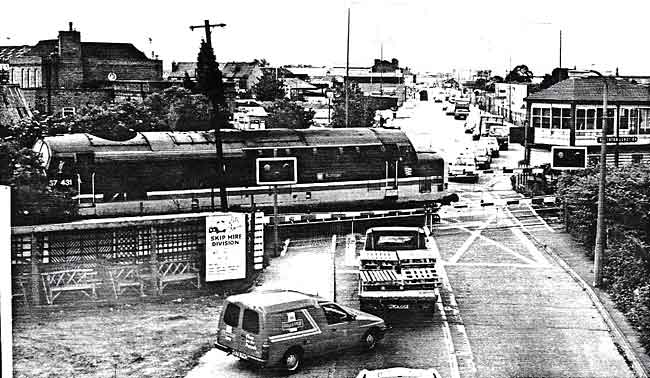 8. As a postscript, two much more recent photographs are offered. Here, in June 1991, Meadow Lane is still a through route for road traffic, and the closing of the crossing gates continues to result in queues of vehicles in both directions. An eastbound class 37 locomotive, no. 37341 'Bullidae', passes the premises of City Fencing, who occupied that Meadow Lane site for many years. As yet there is no sign of the Manvers Street Link road works, which will soon radically change the Meadow Lane scene a few yards beyond the signal box. There being no longer a convenient footbridge to use as a vantage point, the photograph was taken by means of a bit of harmless trespassing on the old Great Northern bridge.
8. As a postscript, two much more recent photographs are offered. Here, in June 1991, Meadow Lane is still a through route for road traffic, and the closing of the crossing gates continues to result in queues of vehicles in both directions. An eastbound class 37 locomotive, no. 37341 'Bullidae', passes the premises of City Fencing, who occupied that Meadow Lane site for many years. As yet there is no sign of the Manvers Street Link road works, which will soon radically change the Meadow Lane scene a few yards beyond the signal box. There being no longer a convenient footbridge to use as a vantage point, the photograph was taken by means of a bit of harmless trespassing on the old Great Northern bridge.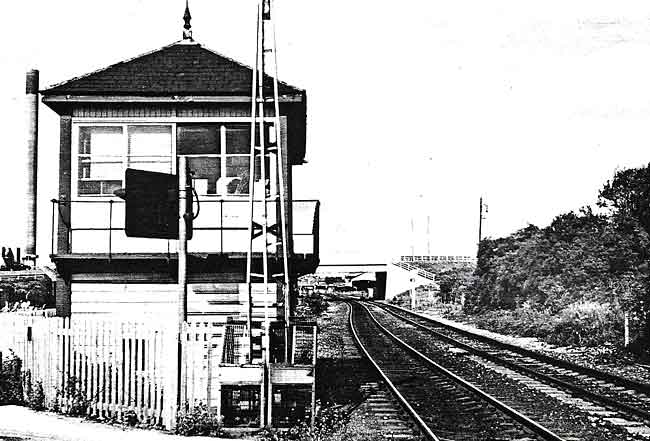 9. Finally, by August 1992, Meadow Lane has become a traffic byway, with the building of the Manvers Street Link, whose bridge and embankment largely blot out the view from Meadow Lane to the west. The junction by the signal box has gone, and it requires a sharp eye to see where the line used to diverge. Across the tracks, vegetation is rampant, and the railway formation at this point has reverted to what existed between 1846 and 1857. As previously mentioned, the signal box is still in use, but one does not expect it to last much longer. Through the bridge arch can be glimpsed that other improbable survivor, London Road Low Level Station.
9. Finally, by August 1992, Meadow Lane has become a traffic byway, with the building of the Manvers Street Link, whose bridge and embankment largely blot out the view from Meadow Lane to the west. The junction by the signal box has gone, and it requires a sharp eye to see where the line used to diverge. Across the tracks, vegetation is rampant, and the railway formation at this point has reverted to what existed between 1846 and 1857. As previously mentioned, the signal box is still in use, but one does not expect it to last much longer. Through the bridge arch can be glimpsed that other improbable survivor, London Road Low Level Station.TAILPIECE... Since the completion of this article, I have learnt of further developments at Meadow Lane Crossing. Fences have being erected across the roadway, which is no longer accessible to motor vehicles, and the full lifting barriers will consequently be redundant. I understand that these are to be removed soon, and will be replaced by a gate giving access across the line for pedestrians, as at Trent Lane Crossing. The signal box has lost its nameboard, and is looking decidedly down-at-heel, but I am told by a most reliable source that it is not to be done away with in the near future.
My thanks go to Gilbert Clarke, who managed to get prints from my inexpert slides, taken with a basic miniature camera, in what I remember, at this remove in time, to have been often indifferent light. Oddly enough, gloomy weather actually seemed to enhance the atmosphere of Sneinton's working railway, and to be its perfect accompaniment.
< Previous
